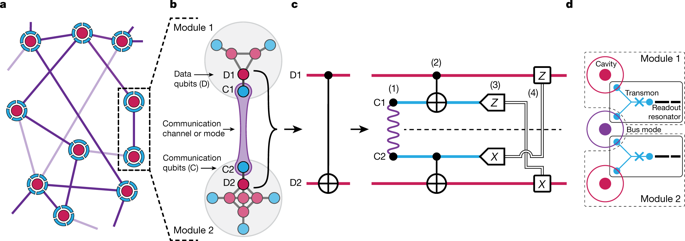Our official English website, www.x-mol.net, welcomes your feedback! (Note: you will need to create a separate account there.)
Deterministic teleportation of a quantum gate between two logical qubits
Nature ( IF 64.8 ) Pub Date : 2018-09-01 , DOI: 10.1038/s41586-018-0470-y Kevin S. Chou , Jacob Z. Blumoff , Christopher S. Wang , Philip C. Reinhold , Christopher J. Axline , Yvonne Y. Gao , L. Frunzio , M. H. Devoret , Liang Jiang , R. J. Schoelkopf
Nature ( IF 64.8 ) Pub Date : 2018-09-01 , DOI: 10.1038/s41586-018-0470-y Kevin S. Chou , Jacob Z. Blumoff , Christopher S. Wang , Philip C. Reinhold , Christopher J. Axline , Yvonne Y. Gao , L. Frunzio , M. H. Devoret , Liang Jiang , R. J. Schoelkopf

|
A quantum computer has the potential to efficiently solve problems that are intractable for classical computers. However, constructing a large-scale quantum processor is challenging because of the errors and noise that are inherent in real-world quantum systems. One approach to addressing this challenge is to utilize modularity—a strategy used frequently in nature and engineering to build complex systems robustly. Such an approach manages complexity and uncertainty by assembling small, specialized components into a larger architecture. These considerations have motivated the development of a quantum modular architecture, in which separate quantum systems are connected into a quantum network via communication channels1,2. In this architecture, an essential tool for universal quantum computation is the teleportation of an entangling quantum gate3–5, but such teleportation has hitherto not been realized as a deterministic operation. Here we experimentally demonstrate the teleportation of a controlled-NOT (CNOT) gate, which we make deterministic by using real-time adaptive control. In addition, we take a crucial step towards implementing robust, error-correctable modules by enacting the gate between two logical qubits, encoding quantum information redundantly in the states of superconducting cavities6. By using such an error-correctable encoding, our teleported gate achieves a process fidelity of 79 per cent. Teleported gates have implications for fault-tolerant quantum computation3, and when realized within a network can have broad applications in quantum communication, metrology and simulations1,2,7. Our results illustrate a compelling approach for implementing multi-qubit operations on logical qubits and, if integrated with quantum error-correction protocols, indicate a promising path towards fault-tolerant quantum computation using a modular architecture.A teleported controlled-NOT gate is realized experimentally between two logical qubits implemented as superconducting cavity quantum memories, thus demonstrating an important tool for universal computation in a quantum modular architecture.
中文翻译:

两个逻辑量子位之间量子门的确定性隐形传态
量子计算机具有有效解决经典计算机难以解决的问题的潜力。然而,由于现实世界量子系统中固有的错误和噪声,构建大规模量子处理器具有挑战性。解决这一挑战的一种方法是利用模块化——一种在自然界和工程中经常使用的策略,以稳健地构建复杂系统。这种方法通过将小型专用组件组装到更大的架构中来管理复杂性和不确定性。这些考虑推动了量子模块化架构的发展,在这种架构中,单独的量子系统通过通信通道 1,2 连接到一个量子网络中。在这种架构中,通用量子计算的一个基本工具是纠缠量子门3-5的隐形传态,但迄今为止,这种传送还没有被实现为确定性操作。在这里,我们通过实验演示了受控非 (CNOT) 门的隐形传态,我们通过使用实时自适应控制使其具有确定性。此外,我们通过在两个逻辑量子位之间设置门,在超导腔的状态下冗余编码量子信息,朝着实现稳健、可纠错的模块迈出了关键一步。通过使用这种可纠错编码,我们的传送门实现了 79% 的过程保真度。传送门对容错量子计算有影响 3,并且当在网络中实现时,可以在量子通信、计量学和模拟 1、2、7 中具有广泛的应用。
更新日期:2018-09-01
中文翻译:

两个逻辑量子位之间量子门的确定性隐形传态
量子计算机具有有效解决经典计算机难以解决的问题的潜力。然而,由于现实世界量子系统中固有的错误和噪声,构建大规模量子处理器具有挑战性。解决这一挑战的一种方法是利用模块化——一种在自然界和工程中经常使用的策略,以稳健地构建复杂系统。这种方法通过将小型专用组件组装到更大的架构中来管理复杂性和不确定性。这些考虑推动了量子模块化架构的发展,在这种架构中,单独的量子系统通过通信通道 1,2 连接到一个量子网络中。在这种架构中,通用量子计算的一个基本工具是纠缠量子门3-5的隐形传态,但迄今为止,这种传送还没有被实现为确定性操作。在这里,我们通过实验演示了受控非 (CNOT) 门的隐形传态,我们通过使用实时自适应控制使其具有确定性。此外,我们通过在两个逻辑量子位之间设置门,在超导腔的状态下冗余编码量子信息,朝着实现稳健、可纠错的模块迈出了关键一步。通过使用这种可纠错编码,我们的传送门实现了 79% 的过程保真度。传送门对容错量子计算有影响 3,并且当在网络中实现时,可以在量子通信、计量学和模拟 1、2、7 中具有广泛的应用。



























 京公网安备 11010802027423号
京公网安备 11010802027423号